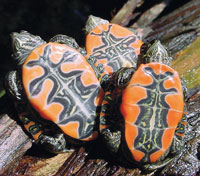Western painted turtle breeding tips.
Ambitious turtlekeepers can breed western painted turtles (Chrysemys picta bellii) in captivity. Males and females may be housed together if provided with ample space, but closely monitor behavior during their first introduction and at regular intervals during the spring breeding season. An adult pair can be safely housed in a 75-gallon tank, but 100 gallons or more is preferable.

Photo by Paul Vander Schouw
Even as hatchlings these turtles display brilliant plastral colors and patterns.
Western painted turtles are not normally considered an aggressive species, but always err on the side of caution. Separate antagonistic animals at the first signs of aggression, and reintroduce these turtles for breeding only for brief periods under careful supervision.
After successful copulation, the gestation period is brief. Females usually are ready to nest within a month or two. Detect the presence of shelled eggs through palpation. While holding the female in a head-up orientation, gently insert fingers into the inguinal cavity, the space between the hind legs and the bridge of the shell. Gravid females may also discontinue feeding, spend excessive time basking and/or attempt to get out of the tank.
Nesting
If a nestbox is not provided as part of the turtle’s normal captive habitat, supervised “walks” can be permitted in the yard to allow gravid females to nest naturally. If this option is neither successful nor possible, a gravid female can be induced under the care of an experienced reptile veterinarian.
Female western painted turtles are quite fecund. They routinely produce two clutches of eggs per season. Occasionally a third and even fourth clutch is produced, but the number of eggs decreases with each subsequent clutch. Typical clutches have four to 10 eggs, which range in size from 1 inch long and three-fourths inch wide to up to 1½ inches long and 1 inch wide. Egg size and clutch density are directly proportional to the female’s size, so larger females produce larger eggs and larger clutches.
Incubation and Hatching
Western painted turtle eggs can be incubated in a number of ways, but one consistently successful technique utilizes damp sphagnum moss as a substrate. Primary and backup thermometers are recommended to ensure that incubation temps remain between 82 and 86 degrees Fahrenheit. This range is optimal for healthy embryo development and hatching. The sphagnum moss substrate can be remoistened as required to prevent desiccation (drying out) and egg failure. Simple wafer-type thermostats have proven to be reliable, and they are recommended because they are easy to use.
After roughly 60 days, eggs begin to “sweat” within a few days of hatching. Hatchlings may take several hours to several days to fully emerge from their eggs. They should remain in the incubator long enough for full absorption their residual yolk sacs.



